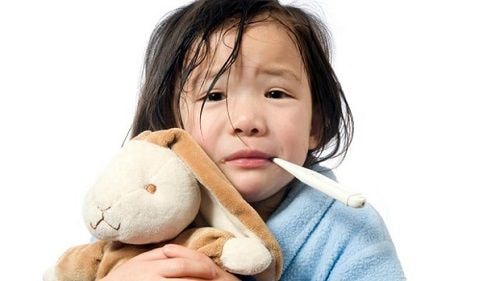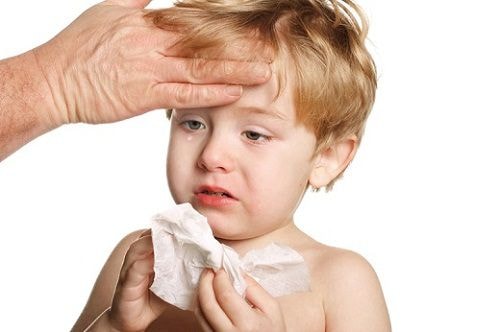Common diseases in children during the changing seasons
The changing weather from autumn to winter with erratic rain and sunshine and dryness makes children susceptible to pathogens such as bacteria and viruses.
The change from autumn to winter causes temperatures to fluctuate, being relatively high during the day but cold at night. These changes create favorable conditions for disease-causing bacteria to thrive.
Children have weak immune systems, their bodies have not yet adapted to environmental changes during the changing seasons, causing their resistance to decrease, so this is the stage when diseases break out in children.
Below are common childhood illnesses when the weather changes from fall to winter.
 |
| Common childhood illnesses during seasonal changes can become dangerous if not treated promptly. |
Sore throat, pharyngitis
The disease is caused by bacteria, the symptoms often occur suddenly such as sore throat, chills, fever, headache, nausea and even occasional vomiting. The throat is red and the tonsils are swollen, sometimes there are lymph nodes. Mothers need to take their children to the doctor to check the throat, diagnose the disease. The doctor will prescribe antibiotics for 10 days. Children can go to school after 1 day of taking the medicine.
Acute diarrhea
The vast majority of cases of acute diarrhea are caused by eating contaminated food. The cause of diarrhea can be pathogenic microorganisms such as bacteria (dysentery, typhoid, cholera, etc.) or viruses, fungi, intestinal parasites. Acute diarrhea can occur at any age, but 80% occur in children under 2 years old.
Diarrheal agents often cause disease through the fecal-oral route: Feces of people with diarrhea contaminate food and water or come into direct contact with the source of infection. Give your child plenty of fluids such as ORS or fruit juice. If your child has severe diarrhea, take him or her to a medical center early for early and proper treatment.
Flu
Colds are caused by viruses and are spread through the air or by direct contact with an infected person. People with colds often have a stuffy or runny nose, fever, headache, cough, sore throat, or fatigue.
Influenza is a viral respiratory illness. It is spread through the saliva, nasal discharge/phlegm of an infected person. Symptoms of influenza include fever, muscle aches, dry cough, runny nose, nasal congestion, headache, and fatigue.
 |
| Flu is a common disease in children when the weather changes from fall to winter. |
There is no cure for either of these illnesses, but rest and fluids are recommended. Your child should be kept home from school for a few days. There is a flu vaccine available, but you should consult your doctor before having your child vaccinated.
Fever of unknown origin
Many children who are playing normally suddenly have a fever, parents need to pay attention to rehydration and fever reduction for children. If not rehydrated well, children will lose electrolytes, combined with high body temperature will lead to complications such as convulsions, coma, threatening the child's life. When children have a fever, they should be kept in a cool place, dressed in thin clothes, cooled, bathed in warm water and if the child has a convulsion, lie on his side in a cool place and clean his mouth and call an ambulance.
Osteoarthritis
Osteoarthritis, especially rheumatism, is common in children aged 5-15 years old. The disease develops rapidly in cold weather or when the weather changes. The initial symptoms of the disease are acute red pharyngitis, fever and sore throat.
After 7-10 days, the patient may have high fever, fatigue, paleness, swelling, redness and pain in large joints such as the shoulder and hip joints... lasting for about 5-7 days and then recover, leaving no sequelae. Rheumatoid arthritis needs timely treatment to prevent recurrence and avoid cardiovascular damage.
Some ways to prevent common childhood diseases during the changing seasons
Keep your child warm when the weather turns cold, especially when taking them out in the evening or early morning, in important areas such as the feet, hands, chest, neck, and head. Limit your child's contact with people showing signs of flu or respiratory infections. Give your child warm water to drink, and avoid eating foods taken directly from the refrigerator, ice cream, or ice.
Supplement your child with vitamins and minerals. These are important nutrients that help your child develop physically and mentally as well as develop a healthy immune system. Improving your own body's resistance and that of your family members is a key factor in preventing disease.
According to health and life
| RELATED NEWS |
|---|

